- HOME
- VISIT
- ABOUT
- TOURS
- VISITOR FAQs
- LOCAL RESOURCES
- FAST FACTS
- MOAH HISTORY
- WILLIAMS HOUSE
- VICTORY GARDEN
- BOARD AND STAFF
- EXHIBITS
- CURRENT EXHIBIT
- PERMANENT EXHIBITS
- FUTURE EXHIBITS
- PAST EXHIBITS
- ARCHIVED EXHIBITS
- COLLECTION
- COLLECTION HISTORY
- DONATE TO THE COLLECTION
- SEARCH COLLECTION
- PROGRAMS & EVENTS
- CALENDAR
- ADULT PROGRAMS
- CHILDREN'S PROGRAMS
- ANNUAL EVENTS
- PAST EVENTS
- SPECIAL EVENTS
- GET INVOLVED
- MEMBERSHIP
- VOLUNTEER
- GIFT OPPORTUNITIES
- STAY CONNECTED
- EMAIL SIGNUP
- NEWSLETTERS
- PRESS
- Membership Response
The Mechanics of Dolls
October 27, 2000 - January 28, 2001
Bring me a dolly that laughs and criesOne that can open and shut her eyes.
This plea to Santa Claus from the old song reflects the wishes of millions of children over the decades: a life-like toy that moves and talks. These days, the desires of kids aged from one to 101 are readily filled by walking, talking creatures such as Furby, as well as a full complement of dolls that roller skate, dance, or ride tricycles. However, in earlier times, a walking or talking toy was a rare plaything, scarce and costly.
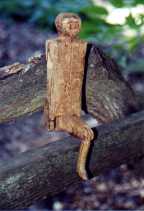 Long before their recorded history began, dolls were shaped from wood and bone, stone and clay, cloth and rags. Early Greek and Roman dolls were typically made of pottery or stone. And for many years, finely crafted dolls were available only to nobility and rich merchant families. By the 17th century, Germany, with its vast forest resources, had become a leading producer of wooden dolls. The commercial floodgates opened for mass production and distribution of dolls in the eighteenth century, when German craftsmen sold throughout Europe and America at prices almost everyone could afford. Among the notable purchasers was George Washington, who wrote to England for "a neat dressed Wax Baby" for his stepdaughter.
Long before their recorded history began, dolls were shaped from wood and bone, stone and clay, cloth and rags. Early Greek and Roman dolls were typically made of pottery or stone. And for many years, finely crafted dolls were available only to nobility and rich merchant families. By the 17th century, Germany, with its vast forest resources, had become a leading producer of wooden dolls. The commercial floodgates opened for mass production and distribution of dolls in the eighteenth century, when German craftsmen sold throughout Europe and America at prices almost everyone could afford. Among the notable purchasers was George Washington, who wrote to England for "a neat dressed Wax Baby" for his stepdaughter.
Fine porcelain heads were developed in Germany and quickly copied in France. Intricate stitching of kid leather joints in arms and legs provided early articulation of limbs, although pinned joints had been used in earlier, more crudely made dolls.
Most dolls in the early years of the United States were rag dolls made from leftover scraps and hand sewn. The ultimate American Doll is Raggedy Ann, first made in the early 1900s, who springs from this tradition.
- Mechanical dolls were the playthings of wealthy adults until the second half of the 19th century, when walking, talking dolls were patented.
- The Walkers:
The early walking dolls were operated by clockwork. A simple bar allowed for the rotation of footed legs as the doll moved forward. The mechanism was covered with a crinoline skirt. A French clockmaker, Steiner, made a wind-up doll that moved her head, raised and lowered her arms, and moved her arms back and forth while walking. A Fleischman & Blodel doll used a chain drive to pull a spring mechanism, which operated wheels in the bottom of the doll's feet.
Simpler mechanisms for walking were in use by the early 1900s. Springs and elastic were used for the hips and the knees, and the doll's heads moved as they walked. A pulley and lever system was introduced in 1939 by the Alexander Doll Co.
- The Talkers:
By the 18th century, several mechanisms were used for speech in dolls:
- Bellows that blew air across a reed when the doll's arm is moved
- Voice box activated with a push button or pull string.
- Air blown across a set of reeds
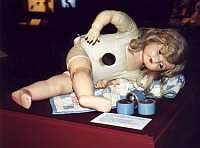 Later designs used mechanical phonographs, tape recorders and electronic synthesizers to give dolly a voice. The first talking dolls were delicate and prone to easy breakage. And after a short time, the voice became difficult to understand. (Dolly Rekord, shown at the right, is typical of the period. She could walk as well as talk.) By the second half of the 20th century, reliability had improved to at least adequate, but the mechanical recordings were still subject to wear. Not until the use of tape recorders did voice quality achieve truly satisfactory intellegibility, and it required the use of electronic voice synthesis to truly achieve long term reliability.
Later designs used mechanical phonographs, tape recorders and electronic synthesizers to give dolly a voice. The first talking dolls were delicate and prone to easy breakage. And after a short time, the voice became difficult to understand. (Dolly Rekord, shown at the right, is typical of the period. She could walk as well as talk.) By the second half of the 20th century, reliability had improved to at least adequate, but the mechanical recordings were still subject to wear. Not until the use of tape recorders did voice quality achieve truly satisfactory intellegibility, and it required the use of electronic voice synthesis to truly achieve long term reliability. - The Lookers:
Moveable, or "sleep" eyes, operated by weights or wires were first used in the 19th century. By 1885, the French company, Jumeau, had developed a "half-spherical" eye that enabled their 'bebe' to raise and lower its eyes. Simon & Halbie then introduced "flirting eyes", which moved from side to side. A knob at the back of the head allowed one doll's eyes to be turned to any position, including cross-eyed! Another mechanism used a drum with multiple images of eyes. As the doll was moved, the drum rotated, creating a variety of expressions. The Ideal Toy Company claims to have made the first American "Sleep eyes" doll in 1914.
Note: Storing "sleep eyes" dolls face down will tend to preserve the mechanism by relieving stress on springs and linkages.
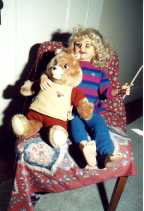 High-tech dolls:
The advent of inexpensive microcomputers influenced the design of dolls and other toys. Beginning in the 1960s, electrically animated figures increasingly became able to perform sophisticated movements, hold a rudimentary conversation, respond to simple commands and do other things previously beyond the capabilities of affordable toys. The application of electronics to animated toys is called "animatronics".
High-tech dolls:
The advent of inexpensive microcomputers influenced the design of dolls and other toys. Beginning in the 1960s, electrically animated figures increasingly became able to perform sophisticated movements, hold a rudimentary conversation, respond to simple commands and do other things previously beyond the capabilities of affordable toys. The application of electronics to animated toys is called "animatronics".
Walt Disney's Ken Forsee was one of the early pioneers in animatronics. In the 1960s and 1970s he helped design the talking Abraham Lincoln figure, "It's a Small World", and other Disney animatronic projects. The key to Disney's technology was the use of specially coded audiotapes, which controlled the synchronization of an animated figure's movements with its associated audio (speech).
Forsse found cost-effective ways to shrink Disney's animatronic technology to toy level. A Texas heiress contributed $15 million to the effort on the condition that the toys would be designed to enhance the quality of play for all children, providing an alternative to the violence in video games, television and movies. The company established to employ Forsee's inventions, "Worlds of Wonder", was headquartered in Fremont, California. Its first product was Teddy Ruxpin, an animated, talking teddy bear. It was an overnight success.
Within three years, the company employed over 400 workers. Follow-on innovations included the microprocessor powered interactive dolls Pamela and Julie, GT Super Screamer race cars and the Laser Tag game.
Despite initial success, problems with rising development and advertising costs impacted both profitability and growth. By 1991, Worlds of Wonder was bankrupt and ceased operations. Its products were licensed to Hasbro, which continued to sell Teddy Ruxpin until 1997. To date, over 40 million Teddy Ruxpins have been sold -- enough to populate a small nation.
Atari's Nolan Bushnell was another leader in animatronics. Recognized as the pioneer of the video game industry, Bushnell went on to found Chuck E. Cheese restaurants, complete with a full cast of animatronic actors. Later he dreamed up a personal robot company, where robots would help people accomplish the routine tasks in their daily lives. This product line never materialized, but much of the technology was transferred to the Axlon Toy Company, where it was used to develop much lower cost products such as the A.G. Bear and a series of whimsical sound activated toys called "Petsters".
One of the hottest high-tech toys of today is the robotic dog. Sony started the trend with its $2000 version of the pet. Ten other companies followed Sony's lead, and today the market is filled with different breeds of robotic dog -- including one with a built in cyberflea.
Hasbro and Mattel are the largest toy companies today, but competition is fierce and the high-tech toy industry promises to continue to evolve and flourish, creating new products, new competitors and new delights.
Exhibit Companion
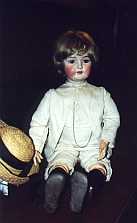 Child dolls
: European dolls were often made large enough to allow the doll to be clothed in the garments of small children. The hand me down of the last child of a wealthy family often appeared on such a figure. The doll shown on the left is of French manufacture.
Child dolls
: European dolls were often made large enough to allow the doll to be clothed in the garments of small children. The hand me down of the last child of a wealthy family often appeared on such a figure. The doll shown on the left is of French manufacture.
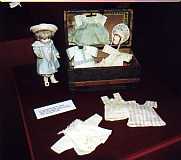 German wardrobe doll
: This doll (right) has a bisque head, typical of German made dolls of the period. She came fully equipped, with a wardrobe trunk containing several outfits. Other features include sleepy eyes, human hair wigs and a jointed composition body.
German wardrobe doll
: This doll (right) has a bisque head, typical of German made dolls of the period. She came fully equipped, with a wardrobe trunk containing several outfits. Other features include sleepy eyes, human hair wigs and a jointed composition body.
Schoenhut doll : Designed by Albert Schoenhut and made of wood and steel, these dolls, circa 1920, could be positioned in arbitrary poses and would remain indefinitely as posed. The spring joint design was patented in 1911. Holes in the feet and shoes fit prongs on the doll's stands. These were the first dolls able to maintain various poses.
Character dolls
: Dolls portraying well known personages, both real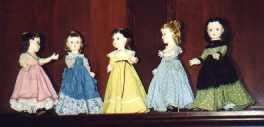 and fictional have always been popular. Typical examples include Sonja Henie, Shirley Temple, Scarlett O'Hara, Snoopy, and Alcott's "Little Women", (manufactured by the Alexander Doll Company, a well known manufacturer of dolls) portrayed on the left. The Alexander Doll COmpany, founded in 1923 on a kitchen table by Beatrice Alexander-Behrman, was the first to produce a doll based on a licensed character (Scarlett O'Hara). Other popular fictional characters include Snow White and the Seven Dwarfs, Micky Mouse, Alice in Wonderland and Winnie the Pooh. It is arguable that anyone who achieved fame as an entertainment personality in the 20th century probably had a doll, or several, being manufactured in their likeness, if only for commercial exploitation.
and fictional have always been popular. Typical examples include Sonja Henie, Shirley Temple, Scarlett O'Hara, Snoopy, and Alcott's "Little Women", (manufactured by the Alexander Doll Company, a well known manufacturer of dolls) portrayed on the left. The Alexander Doll COmpany, founded in 1923 on a kitchen table by Beatrice Alexander-Behrman, was the first to produce a doll based on a licensed character (Scarlett O'Hara). Other popular fictional characters include Snow White and the Seven Dwarfs, Micky Mouse, Alice in Wonderland and Winnie the Pooh. It is arguable that anyone who achieved fame as an entertainment personality in the 20th century probably had a doll, or several, being manufactured in their likeness, if only for commercial exploitation.
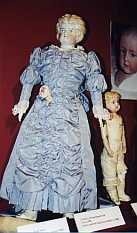 German and French dolls
: Produced around 1900, these dolls have bisque heads and bodies constructed of kid leather or composition material.
German and French dolls
: Produced around 1900, these dolls have bisque heads and bodies constructed of kid leather or composition material.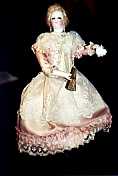 This type of doll is now a collector's item. Earlier European dolls produced in the 1700s, especially French dolls, were used to display
current European fashions (right) and were popular exports even to the colonies of European powers. Even during wars, when ports were closed to most ships, fashion dolls were usually allowed through. The 1830 period dolls of Steiner, a French producer, could kick, "cry" and roll over. Jumeau's "Talking Bebes", also French made, were produced in the late 1800s.
This type of doll is now a collector's item. Earlier European dolls produced in the 1700s, especially French dolls, were used to display
current European fashions (right) and were popular exports even to the colonies of European powers. Even during wars, when ports were closed to most ships, fashion dolls were usually allowed through. The 1830 period dolls of Steiner, a French producer, could kick, "cry" and roll over. Jumeau's "Talking Bebes", also French made, were produced in the late 1800s.
Wax dolls : Some dolls were manufactured with wax heads. Their bodies were usually made of cloth, leather ceramic or composition material.
Cloth dolls
: Beloved by children for their cuddly and snugly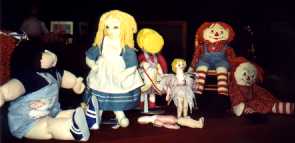 character, cloth dolls have been made for as long as cloth has been
produced. Among the better known are Raggedy Ann and Raggedy Andy and, more recently, the Cabbage Patch Kids. Cloth dolls were sometimes made from felt, some exquisitely painted and decorated. The dolls of Italy's Lenci company incorporated jointed legs and head, painted features, and felt clothing. The Lenci Company is famous for its beautifully dressed felt dolls, produced from 1920 onwards.
character, cloth dolls have been made for as long as cloth has been
produced. Among the better known are Raggedy Ann and Raggedy Andy and, more recently, the Cabbage Patch Kids. Cloth dolls were sometimes made from felt, some exquisitely painted and decorated. The dolls of Italy's Lenci company incorporated jointed legs and head, painted features, and felt clothing. The Lenci Company is famous for its beautifully dressed felt dolls, produced from 1920 onwards.
Animated dolls
Puppets : Moved by sticks, strings or the inserted hand of their animator, puppets were the earliest form of animated doll. Hand puppets and string puppets are widely known in Western cultures, but the shadow show, which has its roots in China, is less familiar. The shilouettes of the stick-activated, carved and painted leather puppets, projected on the screen, play their roles while accompanied by instrumental or vocal music.
Automatons : Driven by spring-wound clockwork, most of these dolls played music as they moved. It was not unusual for these dolls to be able to move arms, legs and head independently -- at least until they got that run-down feeling. The Writer, a famous automaton first exhibited in 1774 was able to write simple messages. Designed by Pierre Jacquot Droz, it represented a three year old child writing with a quill pen. As he writes, his eyes turn to follow his moving hand. He could write a sentance of up to forty letters.
Modern talking mechanical dolls : 20th century talking dolls often used a pull cord to wind a spring, which powered a mechanical phonograph and sometimes facial features and movable limbs as it unwound. The phonograph mechanism was constructed to permit a number of different phrases to be played back at random. "Chatty Cathy" was probably the best known of these, but there were many others.
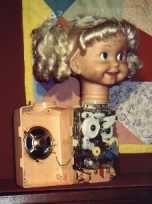 Electronic dolls
: After 1970, dolls often used tape recorders to produce their voices. Body movements could be synchronized with the sound using a multi-track tape format, one track containing the voice and the other track containing programmed commands controlling motors that animated limbs and facial features. Changing the tape changed the actions the doll performed.
Electronic dolls
: After 1970, dolls often used tape recorders to produce their voices. Body movements could be synchronized with the sound using a multi-track tape format, one track containing the voice and the other track containing programmed commands controlling motors that animated limbs and facial features. Changing the tape changed the actions the doll performed.
Some dolls, such as Teddy Ruxpin and other Worlds of Wonder toys, could be connected together to hold a conversation or sing in chorus. Teddy Ruxpin was THE toy of the 1985 holiday season and was in short supply everywhere. This success caught the attention of competitive toy companies and other media character companies. The Walt Disney organization, Jim Henson Associates (Muppets), and King Features Syndicate (Peanuts) licensed their characters to Worlds of Wonder for use with its "animagic" technology. Additional creations included a talking Mother Goose, Mickey Mouse, Goofy and Snoopy. In addition, Worlds of Wonder created two microprocessor-based, interactive dolls - Pamela and Julie.
Worlds of Wonder went public and became an overnight darling of Wall Street as its price shot up. Unfortunately, in a brief three and a half years the company filed for protection from its creditors in 1987. Large R&D, advertising, production, distribution, logistical, and repair costs hampered the company's ability to grow as quickly as it wanted to and it soon owed payment to many creditors. Over the next two years, the company reorganized. Worlds of Wonder went on creating new products until 1991, when it closed its doors for good.
Skippy Scribbles, a bear, was created by the Wonderama Toy Company of New Jersey. The company also produced a blond female figure, Susie Scribbles. Once again, a specially recorded two-track cassette tape was used to produce both audio signals and special motor control signals that would drive three servomotors. These motor signals drove a robotic arm with three joints - a shoulder, elbow, and wrist. Skippy and Susie could both write and draw.
Each character sold for about $70, and included a desk, paper and introductory tape. The subject content of the cassette tapes was more scholastic than any previous toys. Ideally, a child would have his own pencil and paper, drawing along while Skippy or Susie demonstrated their "scribbling." Besides tapes of Mother Goose stories and nursery rhymes, there were also tapes devoted to math, spelling, French language, history, the alphabet, and connect-the-dot art. The robot arms on Skippy and Susie performed beautifully but were relatively fragile.
Interactive dolls : Microelectronics greatly enhanced the capabilities of dolls and other toys, allowing them to respond to simple stimuli such as sharp noises or sequences of claps. The Axlon Petster, for instance, could recognize the number and pattern of claps, moving forwards, backwards, spinning, turning and blinking LED eyes. They could also purr, growl, squeak or emit other noises appropriate to the creature represented. Dolls (Jill is an example) acquired the ability to speak phrases in response to detected sounds. More sophisticated dolls, such as Julie, incorporated microprocessors. They could actually recognize simple words and phrases and respond appropriately. The ubiquitous Furby and Sony's Aibo robotic dog are Julie's technological descendants.
Bibliography
Web sites
Antique Doll Collector
- A full color magazine
devoted to doll collecting. In every issue you'll enjoy articles by leading doll experts, trips to spectacular museums, important doll shows and auctions, and a calendar of events, plus advertising from the world's foremost antique doll dealers.
Alexander Doll Company
- The only major
manufacturer of handcrafted dolls in America. Founded 75 years ago by Madame Beatrice Alexander-Behrman. She initiated a series of firsts in the toy industry, including the first doll based on a licensed character (Scarlett from Gone With the Wind), which led to the creation of dolls based on characters from popular motion pictures.
A Doll's House
- An online doll museum of vintage dolls made in America before 1960. Makers include Madame Alexander, Vogue, Nancy Ann Storybook, Ideal, etc. Tons of pictures of vintage dolls.
United Federation
Doll Club
- A non-profit organization with the goal of being the
foremost in research, conservation, collecting and appreciation of
dolls. Site includes archives of catalogs, research materials and
other ephemera relating to dolls.
Books
The Care of Favorite Dolls: Antique Bisque Conservation Mary G. Caruso, Hobby House Press, Inc., 7/99 ISBN:0875885454
Doll Makers & Marks: A Guide to Identification Dawn Herlocher, Antique Trader Books, 4/99, ISBN: 1582210004
Doll Values: Antique to Modern Patsy Moyer, Collector Books
Madame Alexander Dolls: An American Legend Stephanie Finnegan, Alexander Doll Company/Portfolio Press, 1999
Credits
Photography: Wayland Lee, Bob Katzive
Our Special Thanks
The Museum is indebted to many individuals for this exhibit. We commend and thank in particular:
Stan and Marianne Hanel for providing the discussion on animatronic toys and for the loan of many animated dolls and toys for this exhibit.
Margery Grannis for her loan of classical dolls and automatons.
Anadel Law and Joan Engberg of the California Poppies Doll Study Club, who loaned many of the dolls and also provided wonderful entertainment.
Ken and Judy Kormanak, for the loan of the "Little Women".
Beth Bunnenberg, Barbara Cleveland, Lorraine Grippet, Glenda Jackson, Anita Maxwell, Catherine McCausland, Monroe Postman, and all the members of the MOAH Exhibits Committee.

|
This page
last updated: September 26, 2005 Original content: Copyright © 2000, 2001 Museum of American Heritage Trademarks are the property of their owners |
 |
Join today! Membership dues help sustain MOAH. For more information and to download a Membership Form
LEARN MORE HERE
For questions and comments
Contact Us.
Mailing Address
PO Box 1731, Palo Alto, CA 94302
351 Homer Avenue
Palo Alto, California
p. 650.321.1004
e.



